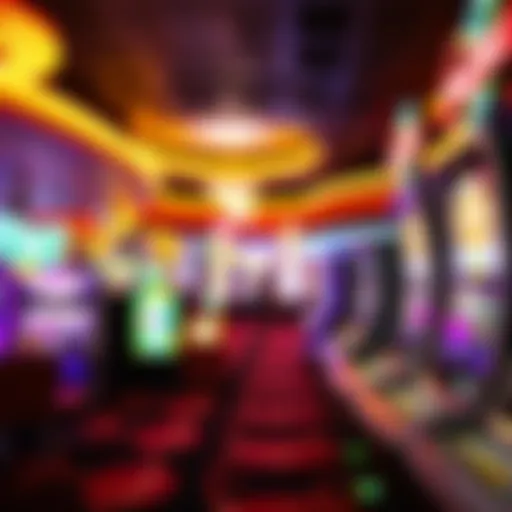Inside the World of 3D Poker Sites: Features and Trends


Intro
The allure of gambling has taken many forms over the years, evolving from backroom card games to modern-day online platforms. In the ever-expanding universe of iGaming, 3D poker sites have carved a unique niche for themselves, allowing players to immerse themselves in a more lifelike experience. Gone are the days when poker was simply about cards and chips—now, the game unfolds in dynamic, visually rich environments that mimic the excitement of a physical casino.
As we embark on this exploration of 3D poker sites, we’ll first take a look at what makes these platforms stand apart from their traditional counterparts. Not only will we analyze the key features that the technology provides, but we'll also dive into the user experience and how it reshapes the way players engage with poker games. Through understanding the dynamics, players can enhance their strategic approach and partake in a deeper, more meaningful gambling experience.
Moving past surface-level analysis, this article will dissect various aspects of the operational mechanics of 3D poker sites, compare them with conventional ones, and examine emerging trends in this space. Whether you’re a seasoned pros at the tables or just dipping your toes into online poker, this comprehensive guide aims to equip you with critical insights and knowledge to navigate the thrilling world of 3D poker.
Prelims to 3D Poker
In today's digital age, the landscape of gambling has shifted remarkably, especially in the realm of poker. Among the key innovations in this field is 3D poker, which brings a fresh breath of life into the online gaming experience. This section aims to offer insights into what 3D poker is all about and why it holds significant weight in the discussion of online poker dynamics.
The essence of 3D poker lies in its ability to replicate the real-life ambiance of poker games while providing players a platform to connect in a more meaningful way. Unlike traditional flat-screen poker, 3D poker immerses players in a vibrant virtual world. This creates a richer atmosphere that combined entertainment and strategy. The benefits of engaging in such an environment are manifold, including enhanced interaction with other players and a more visually stimulating experience.
In a poker world that often feels overwhelming and competitive, the 3D platforms allow players to relax and engage without the usual pressure. This casual yet vibrant approach draws in both novices and seasoned gamblers. It’s not just about the cards on the table; it’s about the entire experience—the sights, sounds, and social connections.
Moreover, as the poker community moves toward a more interactive environment, understanding the implications of 3D poker becomes crucial. Players can develop deeper strategic insights and social nuances that traditional formats may obscure. When we delve into the nuts and bolts of 3D poker in subsequent sections, we will explore its definition, trace its evolution, and dissect its features to provide a comprehensive view.
As we unravel the layers of this innovative gaming style, it's essential to keep in mind that what we discuss is not just a technological trend, but a transformation of how poker is perceived and played in our modern world.
Defining 3D Poker
Defining what 3D poker constitutes is pivotal for anyone looking to dive into the intricacies of this gaming format. In simple terms, 3D poker integrates three-dimensional visuals to create a more realistic and engaging poker environment. Players control avatars, interact with fellow players, and navigate a virtual casino space, all from the comfort of their homes.
Additionally, the graphics typically ooze a level of sophistication tailored for an immersive player experience. This trend has created an entirely new genre of poker that combines traditional mechanics with digital advancements. Whether using a desktop or a mobile device, players can expect an interactive interface that makes them feel like they are sitting in a real poker room.
History and Evolution
The birth of 3D poker can be traced back to the late 1990s when online gambling platforms began to emerge. Initially, these sites offered basic two-dimensional (2D) interfaces that were functional but hardly engaging. As technology progressed, so too did the need for a richer experience. The arrival of faster internet speeds and more powerful computers opened doors to richer graphics.
Early attempts at introducing 3D elements often resulted in clunky interfaces and laggy performance, which limited their appeal. Yet, as developers began to embrace advancements in gaming technology, more polished 3D poker sites started to take shape around the early 2000s. These platforms began to utilize OpenGL and other graphical programming technologies to enhance the user experience.
Today, 3D poker emerges as a solid contender among online gaming formats, offering smoother gameplay combined with stunning visuals and interactive gameplay elements. The evolution of this genre indicates a shift towards an immersive online gambling ecosystem that continues to gain traction in player bases worldwide.
Key Features of 3D Poker Sites
The realm of 3D poker sites offers an array of enticing features that set them apart in the bustling world of online gambling. It's not just about playing cards anymore; it's about crafting an immersive experience that keeps players engaged and invested. With technology rapidly evolving, understanding key features becomes essential for both seasoned pros and newcomers alike. These aspects not only enhance the gaming experience but also serve to attract a diverse audience seeking something beyond traditional platforms.
Graphical User Interface
When you log into a 3D poker site, the first thing that hits you is usually its graphical user interface (GUI). Unlike your run-of-the-mill sites, the GUI in 3D platforms creates an almost lifelike environment. You can see entire tables, complete with chip stacks and other game elements laid out before you. It’s like stepping into a digital poker room without leaving the comfort of your home.
The graphics are often crafted in a way that mimics real life. This includes realistic textures, lighting effects, and smooth animations. A sleek, visually appealing GUI enhances user experience, making navigation easy and intuitive. You want to find that seat or get into a new game without feeling like you're lost in a maze.
"The immersive quality of the 3D user interface brings a fresh perspective to online poker—it's not just a game, it's an experience."
Realistic Player Avatars
Player avatars serve as the face of individuality in 3D poker. Each avatar can be customized to reflect your personality, up to the clothing and accessories. In this virtual space, you can express who you are without uttering a word. It fosters a sense of presence that text-based interactions simply cannot replicate.
Moreover, these avatars behave like real people, displaying animations and reactions depending on the actions taken at the table. It's fascinating to see a simulated grin when you bluff successfully or a frown when your cards don't hold up. This layer of realism adds flavor to the game and helps create a social atmosphere, making players feel as though they are part of a community, even while playing online.
Interactive Game Elements
The interactive elements in 3D poker sites elevate the gaming experience to new heights. Picture this: you're not only placing bets but also interacting with the environment. Want to give your opponent a playful nudge? You can do so through various interactive features. Things like animated poker chips or tables that react to player movements provide a sense of engagement that flat, text-heavy platforms lack.
Additionally, these sites often include features like side games or additional mini-games, further engrossing players. Whether it's a quick blackjack game during downtime or a fun casino trivia challenge, these elements entice players to spend more time on the site, enriching their overall experience.


In summary, the key features of 3D poker sites, such as an engaging graphical user interface, realistic player avatars, and interactive game elements, contribute to making online poker not just a game but a fully immersive experience. For gamblers looking for more than mere numbers and words on a screen, these features offer a refreshing take on traditional poker, enhancing both enjoyment and strategic opportunities.
Technical Aspects of 3D Poker Platforms
In the world of online gambling, the technical aspects of 3D poker platforms play a pivotal role in defining user experience and overall satisfaction. Here, we delve into the technologies that support these sites, the contributions of software providers, and the security measures that ensure a safe gaming environment. Each of these elements is essential for fostering a reliable and enjoyable platform for players.
Underlying Technologies
The foundation of 3D poker sites lies in robust underlying technologies. These platforms utilize a combination of advanced graphics, high-speed internet connectivity, and real-time data processing to create an immersive experience. 3D rendering engines, such as Unity or Unreal Engine, are often employed to develop the stunning visuals that characterize these sites. The use of WebGL technology enables browsers to render 3D graphics without needing additional plugins, ensuring that users can seamlessly dive into their poker games.
Moreover, the interaction of multiple codes and scripts enhances gameplay. Languages like JavaScript, HTML5, and CSS3 facilitate smooth animations and responsive elements. Aspects such as player movements, card shuffling, and other animations depend on these technologies. The greater the technology employed, the more lifelike the experience becomes, offering players a seat at a virtual table that feels very much like the real deal.
Software Providers
An essential consideration for any 3D poker platform is the choice of software providers. Companies like Microgaming, Playtech, and Betsoft are key players in this space, renowned for delivering high-quality gaming solutions. Each provider brings its unique flair, often resulting in variations of themes, game features, and player interfaces.
For instance, a platform powered by Evolution Gaming may focus extensively on live dealer experiences, while another using Microgaming may offer a broader range of traditional poker games. Comprehensive partnerships with leading software developers guarantee that players receive not just content but also innovative features that keep them engaged.
Furthermore, these software providers are responsible for ensuring that games run smoothly and are optimized for performance. Regular updates and patches are a staple, addressing any technical hiccups and guaranteeing that gameplay is as seamless as possible. A well-chosen partner can significantly enhance a site's reputation and trustworthiness among players.
Security Measures
Security remains a top concern for any online gambling site. In the realm of 3D poker, the stakes are even higher due to the integration of real money transactions and sensitive personal data. Therefore, effective security measures are non-negotiable.
A host of encryption technologies, like SSL (Secure Socket Layer), are utilized to protect user data. When players engage with a site's poker room, their information is encrypted, ensuring that it remains confidential. Additionally, reputable platforms often implement two-factor authentication (2FA) to further enhance account security.
Furthermore, many sites adhere to strict regulatory standards, often undergoing audits by independent bodies. Compliance with organizations like eCOGRA or the UK Gambling Commission not only fosters trust but also verifies that games are fair and random. Regularly updating their systems and employing firewalls against hacking attempts are also critical aspects that ensure a smooth, secure gaming experience.
"In the end, it’s the blend of technology, innovation, and commitment to security that shapes the user's journey on a 3D poker site."
By understanding these technical aspects, players can better navigate their experiences on 3D poker sites. The seamless interplay of these technologies, coupled with strong security protocols, ultimately creates an engaging and secure online poker environment.
User Experience on 3D Poker Sites
User experience serves as the backbone of any online gaming platform, and 3D poker sites are no exception. This aspect is pivotal, as it directly influences how players engage with the game, interact with others, and ultimately enjoy their experience. A well-crafted user experience is essential for retaining existing players and attracting new ones. It involves evaluating various elements such as navigational design, graphics, community interaction, and the overall feel of the poker environment.
The significance of user experience in 3D poker lies in its ability to create a sense of immersion. When players feel as if they are seated at a real poker table, not just glancing at statistics on a screen, their emotional connection to the game deepens. This section breaks down the specific components that enhance user experience on 3D poker platforms, examining both its strengths and the potential pitfalls.
Navigational Aspects
Navigational elements in a 3D poker site are crucial for maintaining an effortless workflow. Unlike traditional text-based sites, where options may be confined to mere buttons, the navigational design in 3D environments can offer depth that engages players physically and emotionally. Menus and game options should be intuitive, allowing users to focus more on gameplay rather than getting lost in unnecessary clicks.
Good navigation can include the use of floating menus or context-sensitive help features that provide information right when players need it. The layout depends on a balance between appealing visuals and functional efficiency. If players struggle to find a way to join a game or locate their bankroll information, frustration sets in, and with it, a poor overall experience.
Community Interaction
Chat Features
Chat features in 3D poker sites enrich the user experience considerably, allowing players to engage with one another. They provide a platform for casual banter or strategic discussions, reminiscent of what happens in a physical poker room. The delightful part about chat options is they are not just there for small talk; they significantly promote a sense of community.
A remarkable trait of chat features is the ability to send stickers or emojis. This small touch makes conversations lively and creates a more interactive atmosphere. While anonymity is valued in online poker, fostering an engaging community via chat can transform a solitary gaming experience into one filled with camaraderie.
However, while chat features have many benefits, they can also attract undesirable behaviors. Rude comments or excessive chatter can spoil the mood, making robust moderation and reporting tools vital. Proper frameworks can mitigate such challenges, ensuring that the community enjoys a pleasant experience.
Tournaments and Events
Tournaments and events offer another stellar avenue for player interaction on 3D poker sites. They are not merely competitions; they cultivate camaraderie and excitement. Players can form alliances, strategize, and engage against others, transforming a personal endeavor into a community experience.
A flashy characteristic of these tournaments is their live-streaming capabilities. Seeing someone in action from their perspective—playing cards, observing player reactions—adds a visceral thrill absent in traditional formats. Unique features, such as themed events around holidays or significant sports moments, generate buzz and keep the player base eager to return.


However, these events can also have drawbacks, such as time zone conflicts or varying skill levels among participants, which can lead to dissatisfaction. Finding a balance in scheduling and competitiveness is essential for ensuring that these events offer a fun experience without turning into stress.
When examining user experience in 3D poker sites, one must consider the intricate web of interactions, features, and community engagement techniques. Every element mentioned above plays a crucial role in creating an atmosphere where players are not just participants but feel like integral parts of an engaging social milieu. The future of 3D poker lies in continuously refining these experiences to keep players coming back for more.
Advantages of Playing 3D Poker
Playing poker in a 3D environment offers numerous benefits that enhance the overall gaming experience. These advantages are not just gimmicks; they form the foundation of what attracts players to 3D poker sites over traditional platforms. Here, we dive into the key reasons why 3D poker has garnered a following among gamblers, casino enthusiasts, and professional players alike.
Enhanced Engagement
One of the standout features of 3D poker is its ability to draw players in more deeply than standard online versions. The immersive graphics and interactive elements transform the gaming experience from a simple transactional activity into a compelling journey. In a 3D poker room, every action feels intentional; whether it’s the sound of chips clinking or the subtle movements of avatars, each detail contributes to an atmosphere that keeps players glued to their seats.
Players often report feeling more invested when navigating a well-designed 3D space. It can turn a routine poker night into an engaging session where tactics matter more, and players find themselves thinking three steps ahead. This heightened engagement can lead to longer play sessions, which is something casinos treasure.
Visual Appeal
When it comes to poker, presentation matters; a good visual environment enhances enjoyment and contributes to a player's mood. The graphics in 3D poker platforms are often strikingly realistic, featuring vibrant tables, animated backgrounds, and lifelike character models. It's like being in a high-stakes casino, all while sitting comfortably in your own living room.
"Visual appeal in poker can make or break a player’s experience. It creates an atmosphere where players can enjoy the game without feeling distanced from the action."
This visual allure is also beneficial for attracting new players. A striking user interface can serve as an invitation for those who might be intimidated by traditional poker's rigidity. When first-timers see lively avatars and sleek table designs, it can spark curiosity, easing them into trying their hand at the game.
Social Interaction
3D poker sites shine in fostering social connections among players. Unlike traditional online poker, where interactions can feel flat and disconnected, 3D environments allow for richer social engagement. Players can interact through chat features, seamlessly converse with each other, and even witness animated reactions from their opponents, giving a sense of community.
The ability to participate in multiplayer tournaments and special events further enhances the social dynamics. Meeting folks from around the globe who share a passion for poker can be a delightful bonus, making the gaming experience even more rewarding.
Additionally, the incorporation of avatars contributes to a sense of identity. Players can express themselves visually, enhancing camaraderie when they see familiar faces at the virtual tables.
Challenges Faced by 3D Poker Sites
The landscape of online poker is continually shifting, particularly with the advent of 3D poker sites. While these platforms bring a novel and engaging experience, they also face a range of complex challenges. Addressing these issues is essential for the sustainability and growth of the 3D poker sector. Understanding these challenges helps stakeholders—like players, developers, and marketers—strategize better and make informed decisions.
Technical Issues
Technical hurdles are perhaps the most prominent pain points for 3D poker sites. As these platforms try to create a fully immersive experience, they inevitably encounter problems like server overload and software glitches. During peak times, the servers may struggle to handle the traffic, causing latency or crashes. Such disruptions not only impair the gameplay but can also frustrate players, leading to a potential loss of customers.
Moreover, the graphics-intensive nature of 3D environments requires more from players' devices. Not all players will have access to high-end computers or stable internet connections, which creates a divide. People on older devices or with slow internet may experience stuttering visuals or slow load times, impacting their enjoyment of the game. These technical challenges can ultimately lead to a diminished user experience and hinder the potential growth of 3D poker sites.
Market Competition
The online poker arena is crowded, with countless platforms vying for players' attention. 3D poker sites, although innovative, must contend with traditional sites that offer similar games with less technological fuss. Market competition can be fierce, and differentiating oneself is vital.
Players often gravitate toward platforms they know and trust, making it tough for new 3D sites to break through. Established sites have dedicated user bases and robust marketing strategies, often overshadowing newcomers. Therefore, the challenge lies in developing unique selling propositions, like exclusive 3D features or exceptional customer service, to attract and retain players. As the market grows, 3D poker sites must keep innovating to stand out in a highly competitive environment.
Player Adaptation
Lastly, the transition from traditional to 3D poker can be daunting for some players. Many are accustomed to the simple, text-based interfaces of classic poker. Introducing players to 3D environments means they must adapt not just to new software but a new way of engaging with the game. Some might find the transition overwhelming or unnecessary, which can result in resistance to switching platforms.
Moreover, players who are seasoned in traditional poker may find it challenging to adjust to the additional visual elements and immersive features of a 3D setup. It’s important for 3D poker sites to provide ample tutorials and support to help players navigate these changes. Failure to adequately assist players could erode trust and lead to diminished user satisfaction.
Understanding the challenges faced by 3D poker sites provides a glimpse into the complexities that define their existence in a rapidly changing landscape. Addressing these issues effectively is crucial for both player retention and platform growth.
Comparison with Traditional Poker Sites
In the realm of digital gaming, drawing parallels between 3D poker sites and their traditional counterparts serves an important purpose. Understanding these distinctions sheds light on user preferences and gaming mechanics, allowing both players and developers to navigate this evolving landscape with greater clarity. The significance of this comparison lies in the interaction between visual stimulation, game structure, and player engagement, which directly affect the overall poker experience.
Visual vs. Text-Based Options


When it comes to visual representation in gaming, 3D poker offers an immersive environment that pulls players into a vibrant world filled with animated avatars and intricate designs. Unlike traditional poker sites that rely heavily on text and basic graphics, 3D platforms provide a much more captivating experience. This change of scenery can significantly influence player satisfaction.
- Enhancing Engagement: 3D graphics can draw players in and enhance their desire to engage, while text-based games might lead to more casual interaction.
- Spatial Awareness: Being able to observe the 'table' from different angles adds depth and realism that purely text-based sites lack.
On the flip side, not everyone gravitates towards the bells and whistles. Some players prefer the simplicity and speed of traditional formats, where quick thinking often trumps interesting graphics.
"In a fast-paced game like poker, clarity and function often outweigh glamour."
Game Mechanics and Rules
Game mechanics are a crucial aspect of poker, influencing decisions and strategies on both platforms. While the core rules remain consistent, the presentation is what often diverges:
- 3D Poker: Players can engage in various features such as customizable avatar actions, live animations for chip betting, and other visual cues that signal game phases. This creates a dynamic environment where players feel more involved every step of the way.
- Traditional Poker: Focuses on a straightforward approach; players might find gameplay quicker, given the absence of 3D distractions, but this could well be less engaging after a certain point.
The learning curve may shift when adapting from one format to the other. Users from text-based backgrounds might struggle initially with gestures and interactions that are second nature in a 3D context, while 3D veterans may find standard interfaces lacking in excitement.
User Engagement Strategies
The way players interact can dictate the success of a poker site. 3D poker sites leverage engaging strategies that simply aren’t possible in traditional settings:
- Avatar Interaction: Players can create and customize avatars, fostering a sense of identity at the table that transcends basic usernames.
- Enhanced Social Features: 3D platforms often incorporate engaging chat options, voice communication, and interactive events that bring the community closer together.
- Tournaments and Events: Many 3D environments host elaborate events with real-time visuals, creating a festival-like atmosphere that traditional poker sites often lack. Traditional gameplay might feel static in comparison, emphasizing individual play rather than community interaction.
Yet, traditional poker sites still have their place. For instance, they often provide a more straightforward path for newcomers to learn game fundamentals without the distractions of complex visuals.
Future Trends in 3D Poker Gaming
The realm of 3D poker is not just an ephemeral trend; it's a burgeoning field with potential to reshape the online gaming landscape. As technology continues to advance at breakneck speed, understanding these future trends becomes paramount for players, software developers, and marketers alike. Each element we examine here—virtual reality, artificial intelligence, and regulatory changes—serves not only to enhance the user experience but also to challenge existing paradigms in online poker.
Emergence of Virtual Reality
Virtual reality (VR) is no longer a concept relegated to science fiction; it's inching into the realm of popular online gaming. With immersive environments, players can interact with the virtual poker table as if they were there in person. Imagine placing your bet while gazing into the eyes of your opponents; the psychological aspect of poker takes on a whole new dimension. This tactile engagement can feel more personal, making each hand dealt resonate on a deeper level.
Moreover, VR technology fosters a unique social environment. Virtual poker rooms can accommodate multiple players from across the globe, each controlling an avatar. Players are likely to enjoy an atmosphere that closely mimics a physical casino. No more dull scrolling through screens—now, it feels like stepping into a lively poker room buzzing with chatter and excitement.
The investment in VR technology is substantial, but it’s paving the way for captivating opportunities. Companies that harness this potential may well find themselves at the forefront of the next poker revolution.
AI in Online Poker
AI integration in online poker sites is transforming player experiences in ways previously unimagined. From personalized gaming sessions to sophisticated opponent analysis, AI is an invaluable ally. Algorithms can analyze a player's style, offering insights that help improve their strategies. This adaptability is crucial, as players increasingly seek tailored experiences.
An emergent trend is the use of AI-powered bots for practice. Players can train against advanced algorithms that mimic human behavior. These bots can adjust their tactics based on the human player's decisions, providing a comprehensive training tool that was previously out of reach. While some may raise concerns over the ethics of AI in gaming, the advantages of having a calculated, challenging opponent outweigh the ethical dilemmas.
Still, it's important for poker sites to strike a balance. Transparency from platforms about the use of AI can cultivate more trust and engagement among players who want to know how algorithms impact the gameplay.
Regulatory Changes
As the online gambling landscape evolves, so too does the regulatory environment. Governments worldwide are beginning to scrutinize the gambling industry more closely than ever. Future regulations could impact how 3D poker sites operate, affecting everything from gameplay to player interactions.
For instance, some jurisdictions might demand stricter identification checks or implement age verification systems to protect underage players. Others may require enhanced transparency regarding AI influences on gameplay. While these regulations aim to protect consumers, they can also pose challenges for software developers and marketers.
What does this mean for the future? Companies staying ahead of the curve must remain nimble and responsive to evolving regulations. They’ll need to ensure compliance while still offering an engaging and innovative experience for players. It could also open doors for new opportunities, like partnerships with regulatory bodies to formulate best practices.
Ultimately, understanding these trends is not just an academic exercise; it’s a way to prepare and strategize for the shifts in the 3D poker landscape. Keeping an ear to the ground will empower stakeholders to stay relevant as these technologies and regulations evolve.
Ending
As we draw the curtains on our exploration of 3D poker sites, it’s paramount to reflect on the remarkable intricacies that have emerged through this journey. Understanding these dynamics provides gamblers, casino enthusiasts, and poker players with not just an enhanced gaming experience but also strategic insights into the future of online poker. Key considerations come into play here—how technology and user engagement continue to shape not only the mechanics of the game but also the community that thrives within these platforms.
Summary of Findings
In summary, the findings underline the profound impact of 3D graphics and interactive elements on user experience. Notably, the ability to engage with realistic avatars transforms the mundane act of playing cards into a vibrant social event, drawing players into a more immersive world. Moreover, the technical backbone that supports these sites has evolved, focusing on secure software solutions. This ensures that excitement doesn’t come at the expense of safety. In juxtaposition with traditional online poker, 3D sites not just retain their game mechanics but amplify them through dynamic interactions and social features—an evolution that calls for adaptability on the part of players.
Final Thoughts on 3D Poker Sites
Wrapping up, 3D poker sites are not just a phase in the online gaming scene; they represent a shift toward a more engaging and expansive poker environment. For players looking to up their game, becoming acquainted with these platforms is essential. The ongoing integration of technology, like AI and virtual reality, indicates that the poker world is on the brink of further significant changes. Players need to stay informed and adaptable, whether it’s understanding new regulations or changing market dynamics. In essence, the rise of 3D poker sites signals a broader transformation within online gaming, reshaping how players and platforms interact. As these spaces continue to develop, they hold the promise of a richer, more engaging poker experience.



